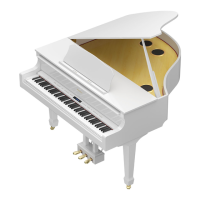8
°
Operation Guide
Adjusting the Overall Volume
You can adjust the speaker volume
when using the internal speakers, or the
headphone volume when headphones are
connected.
Adjusting the volume 0–100 (default value: 50)
Basic operations
Select a setting item
Use the [K] [J] buttons.
Edit the value of an item Use the [–] [+] buttons.
Restore the default value Press the [–] [+] buttons simultaneously.
Transposing the Pitch (Transpose)
The keyboard or song can be transposed in semitone steps.
For example if a song is in the key of E major but you want to
play it using the ngering of the C major scale, you would set
the keyboard transpose setting to “4.”
If you play C E G0It will sound E G B
Kbd Transpose
-6–0–5 (default value: 0)
MEMO
You can also change the keyboard transpose
setting by holding down the [Transpose] button
and pressing the note that will be the tonic
(root note) of the transposed key.
Song Transpose -12–0–12 (default value: 0)
Adding Reverberation to the Sound (Ambience)
The reverberation that is characteristic of a performance in a concert
hall can be added to the sound.
Adjusting the
reverberation (Ambience)
Higher values produce deeper ambience; lower
values produce shallower ambience.
* If Headphones 3D Ambience is “on,” you can
adjust the depth of the Headphones 3D
Ambience eect.
0–10 (default value: 2)
Headphones 3D Ambience
(when using headphones)
You can apply a Headphones 3D Ambience eect
that creates the impression that the sound is being
heard from the piano itself even when you’re using
headphones.
O, On (default value: On)
* The reverberation eect is not applied to audio les.
Adjusting the Brightness of the Sound (Brilliance)
You can adjust the brightness of the sound when you play the
keyboard or when you play back a song.
Adjusting the brightness
of the sound
-10–0–10 (default value: 0)
Making Various Settings (Function Mode)
You can make detailed settings for this piano.
1. Simultaneously press the [Ambience] button and [Brilliance]
button.
2. Use the [K] [J] buttons to select the item that you want to set.
3. Use the [–] [+] buttons to edit the setting.
page
24
Changing the Playing Feel of the Keyboard (Key Touch)
You can change the playing feel (touch) of the keyboard.
Adjusting the key touch
Default
value (50)
This setting is closest to the key touch of
an acoustic piano.
1–100
Higher values make the keyboard feel
heavier.
Fixed (Fix)
Notes sound at a xed volume regardless
of your playing dynamics.
Fix, 1–100 (default value: 50)
Hammer Response
Adjusts the time from when you play the key until
the piano sound is heard. Higher values produce a
greater delay.
O, 1–10 (default value: 1)
In addition to piano sounds, this piano lets you enjoy performing with
many other sounds.
These sounds are called “Tones.” There are ve groups of tones; each
tone button selects a group.
MEMO
For more about the tones, refer to “Tone List” at the end of this manual.
To select a tone
Press a tone button (e.g., [Piano]) and then use the
[–] [+] buttons.
Viewing the display
Tempo
Time signature
Measure
Tone name
Keyboard transposition
Song
transposition
Auditioning the tones (Tone Demo)
1. Hold down the [Key Touch] button and press the [Transpose] button.
2. Select a tone.
You can hear a tone demo in each tone group.
3. To end the tone demo, press the [u] (Exit) button.
Tone groups
Button Explanation
[Piano] button Grand piano tones
[E. Piano] button Electric piano tones
[Organ] button
Organ tones
* If you’ve selected an organ sound that provides
a rotary eect (*1), such as a Combo Jz. Org or a
Ballad Organ, pressing the [Organ] button will
switch the speed of the rotary eect.
[Strings] button
The tones of string instruments such as violins, as
well as other instruments used in orchestras.
[Other] button
Selects a variety of sounds such as bass or
accompaniment sounds.
MEMO
You can use the [K] [J] buttons to select sounds
of the next category.
*1 Rotary is an eect which simulates the sound of rotating speakers. There is a
choice of two settings: Fast and Slow.
Selecting a Tone

